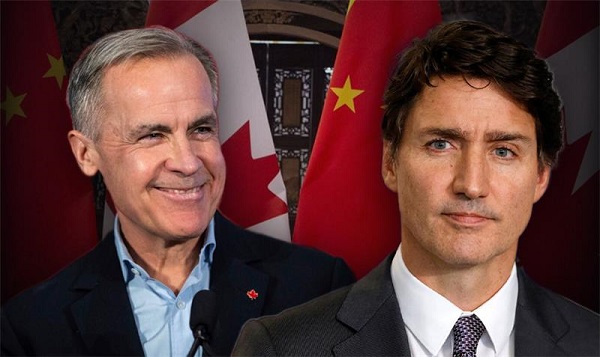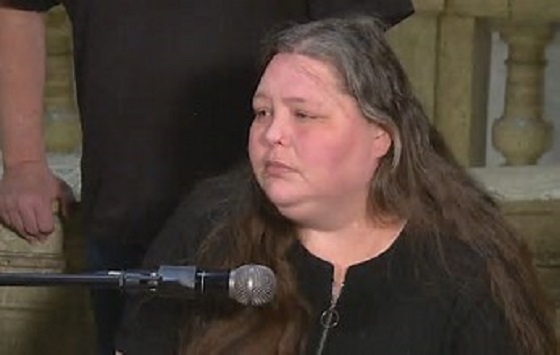MacDonald Laurier Institute
Canada, it’s not racist or xenophobic to talk about immigration

From the MacDonald Laurier Institute
By Joe Adam George
The sustained public antics post-October 7 has caused otherwise pro-immigrant Canadians to question the viability of our current policy
Since 1971, when Prime Minister Pierre Trudeau officially adopted a policy of multiculturalism, Canada has enthusiastically promoted and celebrated cultural diversity as a fundamental element of our national identity.
Perhaps wanting to step out of his father’s shadow and create his own legacy, in 2015, Prime Minister Justin Trudeau upped the multicultural ante by several notches, declaring to the world that Canada would become the “first post-national state”. In a now-infamous interview Trudeau claimed “there is no core identity, no mainstream in Canada.”
Last year, his government announced plans to welcome 500,000 new immigrants per year by 2025 and maintain those numbers annually in the subsequent years. Amidst growing public opposition to high immigration levels, Statistics Canada reported last month that Canada’s population grew by more than 430,000 during the third quarter of 2023 alone, marking the fastest pace of population growth since 1957 and pushing the country’s population past 40.5 million.
PM Trudeau’s pursuit of a post-national vision for Canada – through a blend of substantial hikes in immigration and a systemic push of woke progressivism that has effectively revised and erased Canadian history – has come at a significant cost to Canada’s national unity and security.
Examples of this disunity and lack of social integration have been particularly apparent in recent months. Following Hamas’ October 7 attacks against innocent Israeli civilians, the Jewish community in Canada have been subject to incessant acts of malice and violence by pro-Palestine protestors. Over the last three months, these dissenters have become a nuisance and a threat to all Canadians – from blocking traffic at major intersections and disrupting Christmas celebration events to intimidating businesses and shoppers, and in some extremely worrying instances, plotting to carry out terror attacks on Canadian soil.
Raging antisemitic and anti-Western speeches by controversial Muslim imams like Adil Charkaoui and Sheikh Younus Kathrada have added fuel to the fire (Charkaoui served jail time in 2003 on charges of terrorism and was later allowed a pathway to Canadian citizenship by a judge).
Predictably, questions about uncontrolled immigration and limited social integration have gained considerable prominence in the public square, so much so that the once-taboo topic of immigration could become a hot-button issue in the next federal election. The immigration discourse was already gaining traction on account of joint economic woes and the housing crisis, but the sustained public antics post-October 7 has caused otherwise pro-immigrant Canadians to question the viability of our current policy.
Eric Kaufmann, professor of politics at the University of Buckingham and Senior Fellow at the Macdonald-Laurier Institute, said to me in an interview, “A lot of the talk about integration misses the mark because it only takes into account integration indicators like people getting jobs, learning the language, voting, participating economically and politically, and even feeling a certain attachment to their adopted country, all of which I think are going reasonably well. The main driver for integration problems that we are currently seeing in Western countries is the degree of ethnocultural shifting that is taking place on account of mass immigration. This is bringing a much greater diversity of ethnic identities and religions and results in the importation of overseas conflicts into Western societies leading to inter-communal clashes between groups such as Sikh-Hindu, Muslim-Hindu or Muslim-Jew. The other factor is Islam and its perceived incompatibility with Western culture and values. All this contributes to the rise of populist movements across the globe, particularly in Europe.” Last month, an Angus Reid poll found that more than two-in-five (43%) Canadians believe Islam to be a “harmful presence” to their country.
Out of the over 1.3 million new immigrants who permanently settled in Canada from 2016 to 2021, approximately 1.14 million of them belonged to racialized communities, with most of them coming from South Asian, African and Arab countries. In a 2018 paper, Kaufmann and Matthew Goodwin argue that white Canadians will be a minority around the year 2050. It must be pointed out that this discussion is not about any deranged notion of preserving racial purity but about the effect of quick and massive ethnocultural change. Even with some mixing between cultures, geographic, marital and social patterns remain highly structured by ethnic identity in Canada; this is as true of the majority as of minorities, with white movers avoiding more diverse locations such as Richmond, BC or Brampton, ON. This attachment to one’s own group has been proven in the scholarly literature to be independent of any dislike of outgroups (except at times of violent conflict). Yet any mention of a sense of loss in the disruption of a previously dominant culture is immediately taken as hostility to outgroups and thus racist – a dishonest assessment.
Other countries that have traditionally welcomed a significant number of immigrants are now admitting that their immigration levels are out of control. Leaders (often privately) recognize that while linking immigration to job market needs, infrastructure capacity and economic growth opportunities is vital, greater value ought to be attached to encouraging immigrants to integrate and contribute to advancing a shared national vision. With elections looming in some of these countries, governments are taking belated measures to reduce the overall intake to appease their electorates.
The Danish government has advocated for a “zero refugee” policy. Australia announced new policies that are expected to cut down immigration by 50%. The UK Parliament passed a bill – dubbed “the toughest ever anti-illegal immigration legislation” – which aims to send illegal asylum-seekers to Rwanda. Germany approved legislation that would make it easier for authorities to quickly deport rejected asylum seekers. U.S. lawmakers are negotiating a deal to enforce security along its southern border with Mexico to combat illegal crossings.
It is worth highlighting that Denmark, Australia and Germany are run by left-wing or centre-left governments; mass immigration and social integration can be issues of concern to parties of all political stripes and not limited to “racist right-wing bigots” and “conservatives” as some might lazily portray. When asked which country Canada could take inspiration from to improve immigration controls, Kaufmann mentioned the Social Democrats in Denmark as exemplary.
“I think lowering numbers is absolutely at the heart of any successful immigration policy. I don’t think you can have high [immigration] numbers and not have a problem and you may even have different kinds of problems like antisemitism or anti-LGBTQ sentiments or communal conflicts or radicalization. Essentially, my view is that with high numbers and rapid cultural change, you simply get a loss of social connectedness. You have people in their bubbles moving around and that’s fine but when you get two groups that have an issue with each other, then you’re going to either have a conflict or you tend to get less civic-minded”, he said, citing renowned American political scientist, Robert Putnam’s thesis ‘E Pluribus Unum: Diversity and Community in the Twenty-first Century’. Putnam contends that sharp increases in immigration and ethnic diversity tend to reduce social solidarity and social capital in the short run, meaning social trust (even of one’s own race) would be lower, altruism and community cooperation rarer, and friends fewer, although on the flipside, it is likely to have long-term cultural, economic, fiscal, and developmental benefits.
When asked what continued mass immigration could mean for Canada, Kaufmann said, “I think Canada is moving in the direction of being a low-cohesion society. I mean, if that’s the choice they want to make, that’s fine. I think it’s partly because political correctness is stronger in Canada than almost anywhere else. So, it’s impossible to really have an honest debate about immigration which is one reason why the numbers are so high in Canada compared to other countries. It’s about what the elites will allow you to talk about in a democracy without labeling you a racist, which is completely dishonest, but that’s the way the debate has been conducted in Canada, as some sort of a sacred cow. It’s less sacred in Europe and so there’s more of a real debate around immigration numbers.”
Last month, fueled by concerns over growing antisemitism, the German state of Saxony-Anhalt made it mandatory for applicants wishing to live in the state to recognize Israel’s right to exist. In 2006, the Netherlands made it compulsory for prospective immigrants to watch a film with images of gay men kissing or topless women as part of the civic integration exam to test their readiness to participate in the Dutch liberal society.
When asked if such a values-based test or declaration for prospective immigrants was feasible, Kaufmann said, “People are allowed to have different opinions, even if they may be obnoxious. Even within the citizenry, there are people who don’t recognize the state of Israel and that’s an opinion you’re allowed to have. I think the test should probably focus on subjects like toleration of gays, Jews and women. However, I don’t think Canada is willing to consider qualitative culture-based criteria, such as assimilability to Canadian values, to assess potential immigrants, like they currently do in countries like Denmark, even though I think it would be a good idea. Canadian immigration is completely rooted in voodoo-based reasoning and there’s no economic or demographic rationale to it. The idea that immigration is a sustainable solution to the aging problem, for instance, has been comprehensively debunked. Somehow, it is a religion amongst Canadian elites and to some degree, across political parties. The Conservatives are too scared to touch it out of fear of being branded as racist and anti-immigrant by other parties and the media, even though most of their voters want a lot lower numbers. Regardless, you’ve got a cross-party consensus which is not based in reality.”
In 2016, federal Conservative leadership hopeful Kellie Leitch was heavily criticized, even by members of her own party, for floating the idea of screening out would-be immigrants to Canada, if they were openly intolerant or did not accept Canadian values and traditions such as respect and tolerance for other cultures, freedom of speech and equality.
The systematic dismantling and belittling of Canada’s history by our governments and institutions has left many immigrants seeing very little worth embracing in Canada, often resulting in a retention of their original values– some of which are contradictory to Canadian values and pose a hazard to the safety and security of vulnerable groups like LGBTQ, Jews, women and children.
While Kaufmann does not think Trudeau’s post-national comments have had an impact on the ground on their own, he said they reflect the mindset of the cultural left-dominated or progressive-dominated society.
“The media and the political culture in Canada are dominated by progressivism on any cultural issues, whether that be LGBTQ, religion, ethnicity or immigration. The longstanding narrative in Canadian academia about Canadian identity is that Canada’s just a multicultural country and the only thing it stands for is tolerance and diversity. In a way, multiculturalism is, more or less, a restatement of a post-national country that doesn’t really have a national identity and that’s what the elites want. It is a national identity that claims to have the moral high ground by proclaiming we don’t care about ethnicity or culture because we’re so virtuous and that is really what Trudeau implied. This is still a kind of national identity but based on pride in being holier than thou. His comments reflect an elitist philosophy that has led to record levels of immigration and poor integration.”
The Israel-Hamas war has highlighted the failure of integration inevitably resulting from rapid and uncontrolled mass immigration. Scenes of protestors disrupting Black Friday shopping and Christmas celebrations, or even threatening to kill people in the presence of police officers, were unimaginable in Canada not long ago.
First or second-generation immigrants like me – whether they be permanent residents, students, illegal aliens, or citizens – have immensely benefitted from the magnanimity of Western countries like Canada. In many cases we were offered refuge from the hatred, tyranny, racism, sexism, terrorism, and violence of our home countries. It should not be considered controversial or racist to point out instances of fellow immigrants treating Western generosity and tolerance as weaknesses to be manipulated, bragging about their growing numbers and the political clout they have amassed in liberal democracies (apparently without awareness of the hypocrisy apparent in their support for illiberal tyrannies whose violence drove them to take refuge in the West in the first place). Aaron Wudrick, Director of Domestic Policy at the Macdonald-Laurier Institute, encapsulates this view accurately in his tweet: “The important question isn’t how Canadians identify in terms of ethnicity. It’s whether they identify as *Canadian* and feel any attachment, belonging or commitment to our shared institutions.”
It is dishonest and irrational to label everyone concerned about out-of-control immigration numbers and the need for social cohesion as racist or xenophobic. The sooner we rid ourselves of fallacious name calling, the sooner we can start a serious debate about the best way forward for a compassionate and sustainable immigration policy that prioritizes Canada’s long-term national unity, security and economic interests.
Joe Adam George is a former foreign policy and national security research intern with the Washington, D.C.-based policy think tank, Hudson Institute, and a communications strategist.
International
Beijing’s blueprint for breaking Canada-U.S. unity

By Stephen Nagy for Inside Policy
For several decades, China has pursued a sophisticated campaign to fracture the world’s most integrated defense partnership—that between Canada and the United States.
Beijing’s strategy goes beyond typical diplomatic pressure: it systematically exploits every Canada-US disagreement, transforming routine alliance friction into seemingly irreconcilable divisions. This has become a degree of magnitude easier under US President Donald Trump, with his mercurial policy shifts towards Ottawa. The revelations about Chinese interference in Canadian elections from the Security and Intelligence Threats to Elections (SITE) Task Force – a body comprised of Canadian government and security officials which monitors elections threats – illuminate only one dimension of this comprehensive assault on North American solidarity.
Beijing’s strategic logic is to divide and conquer. By portraying Canada as sacrificing sovereignty for American interests while simultaneously painting legitimate Canadian security concerns as US-driven paranoia, Beijing paralyzes Ottawa’s decision-making and undermines continental defense cooperation.
The 2018 arrest of Huawei CFO Meng Wanzhou crystallized China’s approach. When Canada honored its extradition treaty with the US by detaining Meng at the Vancouver airport, Beijing immediately framed this routine legal cooperation as evidence of Canadian subservience. Chinese state media didn’t simply criticize the arrest, they specifically portrayed Canada as “a pathetic clown” and “running dog of the US.”
Within nine days, China retaliated by detaining Michael Kovrig and Michael Spavor, holding them for 1,019 days. But Beijing’s messaging revealed its true objective. Chinese diplomats repeatedly demanded Canada “correct its mistake” by defying the U.S. extradition request. Ambassador Lu Shaye explicitly stated Canada could resolve the crisis by demonstrating “independence” from Washington.
The economic pressure followed the same pattern. China banned canola imports from two major Canadian companies in March 2019, citing “pests” but Chinese officials privately linked the ban to the Meng case. When targeting Canadian meat exports, Beijing’s timing again coincided with moments of US-Canada cooperation on Huawei restrictions.
China’s wedge strategy extends beyond retaliation to proactive exploitation of bilateral tensions. During the Keystone XL pipeline disputes, Chinese state media amplified Canadian grievances while offering Beijing as an “alternative partner” for energy exports. When the Biden administration cancelled the pipeline in 2021, Chinese diplomats and media immediately highlighted American “betrayal” of Canadian interests.
Similarly, during US-Canada disputes over softwood lumber tariffs and Buy American provisions, Chinese officials consistently present themselves as more reliable economic partners. The message is always the same: American protectionism harms Canadian workers, while China offers stable market access conveniently omitting Beijing’s own coercive trade practices.
On defense, China exploits Canadian concerns about Arctic sovereignty vis-à-vis the United States. When Washington challenges Canada’s claims over the Northwest Passage, Chinese media amplify these disagreements while positioning Beijing as respecting Canadian Arctic sovereignty – even as China declares itself a “near-Arctic state” and seeks military access to the region.
Recent intelligence revelations confirm China’s systematic attempts to influence Canadian politics specifically to create US-Canada friction. According to CSIS documents, Chinese intelligence assessed that a Liberal minority government would be less likely to follow Washington’s harder line on China. Beijing’s interference operations during the 2019 and 2021 elections specifically targeted Conservative candidates perceived as pro-American on China policy.
The Chinese United Front Work Department cultivates Canadian political and business figures through seemingly innocent organizations. A 2020 National Security and Intelligence Committee report found these groups specifically encouraged narratives about American “bullying” of Canada and promoted “made-in-Canada” foreign policies that coincidentally aligned with Chinese interests.
Chinese diplomats regularly exploit Canadian media to amplify anti-American sentiments. During USMCA negotiations, Chinese officials gave exclusive interviews to Canadian outlets sympathizing with “American strong-arm tactics.” When Canada considered banning Huawei from 5G networks, Chinese embassy officials published op-eds in Canadian newspapers warning against following “US tech hegemony.”
China’s wedge strategy carries profound implications for NORAD and continental defense. By creating friction between Ottawa and Washington, Beijing undermines the trust essential for integrated aerospace warning and maritime domain awareness. Chinese military academics have explicitly written about exploiting contradictions in US-Canada defense relations to complicate American force projection.
The stakes are rising as Arctic ice melts. China’s 2018 Arctic strategy specifically mentions differences between Arctic states as creating opportunities for Chinese involvement. Every US-Canada disagreement over Arctic waters provides Beijing openings to position itself as a stakeholder in North American approaches.
Canada and the United States must recognize that their occasional disagreements, normal in any alliance, are systematically weaponized by Beijing. In light of this, at least four responses are essential.
First, Canada and the United States should establish a joint commission on foreign interference that specifically monitors and publicly exposes attempts to exploit bilateral tensions. When China amplifies US-Canada disagreements, coordinated responses can demonstrate alliance resilience rather than division.
Second, create alliance resilience mechanisms that automatically trigger consultations when third parties attempt to exploit bilateral disputes. The Two Michaels crisis revealed how Beijing uses hostage-taking to pressure alliance relationships. A joint response protocol could reduce such leverage.
Third, strengthen Track II dialogues between Canadian and American civil society, business, and academic communities. These networks can maintain relationship continuity even during governmental tensions, reducing Beijing’s ability to exploit temporary political friction.
Fourth, develop coordinated strategic communications that acknowledge legitimate bilateral differences while emphasizing shared values and interests. Honest discussion of disagreements, paired with clear statements about alliance solidarity, can inoculate against external manipulation.
Canada faces the delicate balance of maintaining sovereign decision-making while recognizing that Beijing systematically exploits any daylight between Ottawa and Washington. This isn’t about choosing between independence and alliance. It’s about understanding how Canada’s adversaries weaponize that false choice.
The empirical evidence is clear. From the Meng affair to election interference, from trade coercion to Arctic maneuvering, China consistently pursues the same objective: transforming America from Canada’s closest ally into a source of resentment and suspicion. Every success in this strategy weakens not just bilateral ties but the entire democratic alliance system.
As the Chinese saying goes, 笑里藏刀—a dagger hidden behind a smile. While professing respect for Canadian sovereignty and offering economic partnerships, Beijing wages sophisticated political warfare designed to isolate democratic allies from each other. Recognizing this strategy is the first step toward defeating it. The strength of North American democracy lies not in the absence of disagreements but in the ability to resolve them without external exploitation. In an era of systemic rivalry, the US-Canada partnership must evolve from unconscious integration to conscious solidarity – as different nations with sovereign interests, but united in defending democratic values against authoritarian manipulation.
Stephen Nagy is a professor of politics and international studies at the International Christian University in Tokyo, and a senior fellow at the Macdonald Laurier Institute. The tentative title for his forthcoming monograph is “Navigating U.S. China Strategic Competition: Japan as an International Adapter Middle Power.”
International
Canada’s lost decade in foreign policy

By Joe Varner for Inside Policy
Our allies no longer doubt our values – they doubt our value.
Ten years after promising a return to global relevance, Canada’s foreign policy is defined not by what we do – but by what we fail to do – or fail to show up for.
When Prime Minister Justin Trudeau declared in 2015 that “Canada is back,” he promised to restore the country’s global voice and moral leadership. Ten years later, Canada is indeed back – but not in the way he intended. We are back to irrelevance, back to strategic incoherence, and back to being ignored by allies and adversaries alike. Across a decade of shifting crises, Canadian foreign policy under Prime Ministers Trudeau and Carney have become a case study in good intentions, miserable excuses, poor execution, and chronic unseriousness.
Nowhere was this clearer than in the fight against the Islamic State (ISIS). In October 2014, Stephen Harper’s government committed six CF-18 Hornets, two CP-140 Auroras, and a CC-150 Polaris refueller to the US-led coalition against ISIS, forming the backbone of Canada’s Operation Impact. Canadian aircraft conducted 251 airstrikes in the first six months, striking ISIS positions in Iraq and later Syria. When Trudeau took office in November 2015, his first major foreign-policy act was to withdraw the CF-18s, formally announced on February 8, 2016. The air campaign ended within weeks, replaced by a “train-advise-assist” mission that expanded our trainers in northern Iraq but sharply reduced our combat capability and influence. The decision was framed as moral sophistication but in practice it was viewed as a marked retreat.
The Syrian refugee crisis that erupted in 2015 became the emotional centrepiece of the Trudeau Liberals’ election campaign and his government’s first term – a symbolic gesture of compassion that ignored operational realities. Within weeks of taking office, Ottawa pledged to bring 25,000 Syrian refugees by February 2016, compressing a process that normally took a year into just 100 days. The first flights landed in Toronto and Montreal on December 10, 2015, to global and domestic applause. Behind the scenes, the RCMP and CSIS officials warned that the accelerated timeline left gaps in security screening, and the provinces struggled to provide housing and integration services. It was in the end humanitarian theatre – an election promise kept at the expense of process, capacity, and Canadian national security.
The Syrian refugee crisis saw the Trudeau government jettison Canada’s immigration policy for domestic political purposes. A few years later, when Canadians who had joined ISIS – so-called “foreign fighters” – began to return home between 2017 and 2023, the same government that had championed compassion responded with confusion. Roughly 60 foreign fighters returned to Canada, yet very few were successfully prosecuted under federal anti-terrorism laws. Instead, Ottawa relied on peace bonds, deradicalization programs, and surveillance costing millions of dollars per case. The spectacle intensified in 2022 and 2023 with the repatriation, under court order, of dozens of ISIS brides and their children from Kurdish detention camps. Many arrivals required extensive monitoring and support while families of ISIS victims protested that justice had been denied. The government’s oft-repeated line that “a Canadian is a Canadian” sounded inclusive; it came to symbolize moral inconsistency and policy drift. Critics viewed the hospitality bill reported in the popular press for ISIS Brides and children as an irresponsible fiscal and moral outrage.
Afghanistan was the ultimate test of Canada’s so-called “feminist foreign policy,” and it failed dramatically. When Kabul fell on August 15, 2021, Ottawa was unprepared despite months of intelligence warnings about the Taliban’s advance, and a knowledge of the Biden administration’s draw down and withdrawal. Operation Aegis, Canada’s evacuation effort, began late and ended early. Between August 4 and 26, the Canadian Armed Forces managed three evacuation flights, moving about 3,700 people while allies such as the US and the UK moved tens of thousands. The final RCAF flight departed before the US withdrawal on August 30, leaving hundreds of locally employed interpreters, contractors, and NGO partners stranded. Subsequent reports confirmed that internal direction from the defence minister led officials to prioritize select religious minorities like Sikhs with political connections over interpreters and Afghan women who had worked with Canadian agencies. Veterans and civil-society groups accused Ottawa of politicizing rescue lists while publicly boasting of compassion. For all the talk of empowering women and girls, the people most at risk were left behind in favour of Canadian domestic political interests in the Liberals’ Sikh support base.
In the Middle East, the 2018 rupture with Saudi Arabia remains one of the costliest self-inflicted diplomatic crises in recent memory. A tweet from the Foreign Minister calling for the release of a dissident sparked sweeping retaliation from Riyadh: the expulsion of Canada’s ambassador, suspension of trade and investment, cancellation of flights, and the withdrawal of thousands of Saudi students from Canadian universities. The Gulf Cooperation Council sided with Riyadh, leaving Canada isolated. It took more than four years to rebuild relations, and during that period Ottawa was excluded from key regional energy and security discussions. The episode became a cautionary tale of social-media diplomacy without strategy.
Canada’s approach to Israel and Palestine mirrored the pattern of ambiguity that has defined our broader foreign policy under the Trudeau and Carney liberals. Beginning in 2019, Ottawa reversed a long-standing position by supporting a UN resolution condemning Israeli settlements and endorsing Palestinian statehood – Canada’s first such vote in 14 years. When Hamas launched its October 7, 2023, terrorist attacks against Israel that killed more than 1,200 people, Canada’s initial response was cautious and slow. Statements emphasized proportionality and restraint rather than moral clarity. Two years later, in April 2025, Ottawa recognized a Palestinian state while hostilities with Hamas and other Iranian-backed groups were ongoing. The move alienated allies in Washington and Jerusalem, who warned that premature recognition risked legitimizing a territory still controlled by organizations committed to Israel’s destruction. President Trump went as far as to suggest that Canada had rewarded Hamas for the October 7 terror attack on Israel.
On Iran, engagement drifted into accommodation. After years of delay, Ottawa finally listed Iran’s Islamic Revolutionary Guard Corps (IRGC) as a terrorist entity in 2025 – long after allies such as the United States had done so and only following sustained pressure from Parliament and the families of victims of Flight PS752, which the Iranian Islamic Revolutionary Guard Corps (IRGC) shot down in January 2020, killing 55 Canadian citizens and 30 Canadian permanent residents. The long-overdue designation was more symbolic than strategic. Canada has become, by default, a refuge for individuals linked to the Iranian regime, including relatives of senior officials who live and invest here with impunity. Members of the Iranian diaspora report regular intimidation, surveillance, and threats from Tehran’s proxies operating on Canadian soil – activities that persist despite repeated calls for stronger counterintelligence and enforcement. For all its rhetorical commitment to human rights, Ottawa has failed to translate outrage into action. What passes for engagement with Iran today is less diplomacy than moral fatigue disguised as principle.
Relations with the US fared little better. The renegotiation of NAFTA in 2017–18 produced the United States-Mexico-Canada Agreement (USMCA) – a deal that preserved supply management but conceded ground on automotive exports and dispute-resolution mechanisms. Tariffs on steel and aluminum followed in 2025, and Canada’s retaliatory levies could not hide the reality of diminished leverage. Chronic under–investment in defence and intelligence further eroded trust. When the United States, the United Kingdom, and Australia formed the AUKUS pact in 2021 to share advanced defence technology, Canada was not consulted. In 2022, after years of frustrating delays, NORAD modernization hedged forward but by 2025 Canada had yet committed the full $38 billion required to upgrade continental defences. Years of delay in replacing the CF-18 fighter fleet key to NORAD – starting during the 2015 election campaign by the Trudeau Liberals – only resolved when Ottawa reversed course and ordered the same F-35s in 2023, the same planes that Trudeau once derided. In 2025, Prime Minister Carney placed the F-35 purchase under an election campaign review – reinforcing the impression of drift. To allies, Canada increasingly appeared as a moral commentator rather than a security contributor.
The federal government’s misreading of China compounded the damage. While allies recalibrated against Beijing’s coercion, Ottawa continued to chase trade and investment under the illusion that China could be both partner and rival to play off against the US. That fiction collapsed in December 2018 when Beijing detained Canadians Michael Kovrig and Michael Spavor in retaliation for Canada’s arrest of Huawei executive Meng Wanzhou. The two men spent 1,020 days in secret detention under harsh conditions before their release in September 2021 – the same day Meng returned to China. Ottawa’s response throughout was hesitant, relying on “quiet diplomacy.” Even as other democracies expelled Chinese diplomats and banned Huawei, Canada delayed until 2022, becoming the last member of the “Five Eyes” intelligence alliance to act. Beijing’s execution and death sentences for Canadian citizens in 2019 elicited only muted protest by the Trudeau government. Despite fresh warnings of political interference in domestic affairs and elections campaigns, progress toward a foreign-influence registry remains halting. The cumulative impression is of a government reluctant to confront reality even as its allies in North America, Europe, and Asia are hardening their stance against Beijing.
Europe tells a similar story. The war in Ukraine has exposed the gulf between Canada’s rhetoric and its resources. Although NATO adopted its two-per cent-of-GDP defence-spending target in 2014, successive Canadian governments have treated it more as aspiration than obligation. Publicly, the Trudeau government endorsed the goal; privately, Trudeau told NATO leaders in 2017 that Canada would “never” reach it, a remark later reported in the Washington Post and confirmed by alliance officials. Eight years on, the numbers bear him out. Canada’s defence spending has hovered near 1.4 per cent of GDP, third from the bottom in NATO, even as Poland and the Baltic states have surged past four per cent and re-armed against Russia.
Under Prime Minister Carney, Ottawa now insists that the target will finally be met – on paper at least. In June 2025, the Carney government pledged to reach the spending benchmark by March 31, 2026, under what officials describe as a “re-baselined” accounting framework. In practice, much of the projected increase relies on broad definitions of “defence-related” spending – everything from veterans’ benefits and pensions to Arctic infrastructure and cybersecurity initiatives – that many allies may not accept as true military expenditure. To use a polite phrase, there is considerable voodoo math involved.
Equally puzzling is Ottawa’s rhetorical commitment to a new NATO 5-per cent-of-GDP goal without any credible path or plan to achieve it. Since Russia’s full-scale invasion in February 2022, Canada’s military aid to Ukraine has remained constant but promised weapons shipments have been delayed or cancelled and participation in major NATO exercises curtailed by personnel and equipment shortages. At home, procurement paralysis has left the Canadian Army, Royal Canadian Navy and Royal Canadian Air Force under-equipped and increasingly unready for its primary role of defending Canada. Meanwhile, Ottawa refused for years to leverage Canada’s vast natural-gas reserves to help Europe reduce dependence on Russian energy, insisting there was “no business case” for Atlantic Liquified Natural Gas (LNG) exports. Only after 2025, under Carney, did talk of trade and energy re-engagement resume – too late to shape outcomes. In Brussels, Canada is now viewed less as a dependable ally than as a rhetorical one: a country that still talks like a middle power but spends like a minor one.
The sum of these choices is a Canada that no longer matters as it once did. We are too hesitant to deter, too divided to lead, and too sanctimonious to partner effectively. The language of virtue has replaced the practice of real strategy. Foreign policy is not theatre; it is the disciplined pursuit of national interest, backed by capability and clarity. For ten years we have confused applause at home and sometimes abroad with achievement and hashtags with hard power. The result is a diminished country adrift in an age of international danger – irrelevant in Washington, distrusted in Jerusalem, ignored in Riyadh, dismissed in Beijing, and barely tolerated in Brussels. Our allies no longer doubt our values – they doubt our value.
So, how do we not lose the next decade too? If Canada is to regain its standing, it must first rediscover seriousness. That means returning to the fundamentals of statecraft: credible defence spending, strong military power, clear strategic priorities, and the courage to act rather than advertise. Meeting NATO’s two-per cent commitment must be a floor, not a mirage built on creative accounting. Canada must modernize its armed forces, rebuild its defence industrial base, and restore operational readiness in the Arctic and abroad.
Diplomatically, Ottawa must re-anchor itself within the democratic alliance system – treating Washington, London, and Brussels as indispensable partners rather than convenient props. Engagement with China should be rooted in deterrence and human-rights enforcement, not wishful economics. Canada needs to field a well-equipped brigade in Latvia and lead by example to deter Russia. In the Middle East, Canada must again stand firmly with Israel’s right to exist while pushing back on Iran and its regional proxies.
Canada must once again take a principled stance on human rights and targeted economic development compatible with our national interests and the strategic realities on the ground in regions like Africa.
At home, foreign policy should once again serve national interest rather than transactional domestic political theatre. Canada’s influence was never built on slogans but on capability, credibility, and sacrifice – from Vimy Ridge to Juno Beach and from Kapyong to Kandahar. Those qualities are not lost; they are merely dormant. The path back is not through hashtags or press conferences, but through purpose, power, and principle. Only when Canada stops pretending to lead and starts preparing to lead will the world take us seriously again. If “Canada is back” is ever to mean something again, it must be said not from a podium, but from a position of strength. Power respects power – and until Canada remembers that – no one will remember us.
Joe Varner is a senior fellow at the Macdonald-Laurier Institute and the Center for North American Prosperity and Security, and deputy director of the Conference of Defence Associations.
-

 Great Reset2 days ago
Great Reset2 days agoSurgery Denied. Death Approved.
-

 Business2 days ago
Business2 days agoThe Climate-Risk Industrial Complex and the Manufactured Insurance Crisis
-

 Health2 days ago
Health2 days agoThe Data That Doesn’t Exist
-

 Crime1 day ago
Crime1 day agoInside the Fortified Sinaloa-Linked Compound Canada Still Can’t Seize After 12 Years of Legal War
-

 Great Reset20 hours ago
Great Reset20 hours agoProposed ban on euthanasia for mental illness sparks passionate debate in Canada’s Parliament
-

 Censorship Industrial Complex20 hours ago
Censorship Industrial Complex20 hours agoLiberals gain support for ‘hate speech’ bill targeting Bible passages against homosexuality
-

 Automotive8 hours ago
Automotive8 hours agoThe $50 Billion Question: EVs Never Delivered What Ottawa Promised
-

 Health20 hours ago
Health20 hours agoUS podcaster Glenn Beck extends a lifeline to a Saskatchewan woman waiting for MAiD












